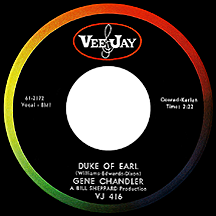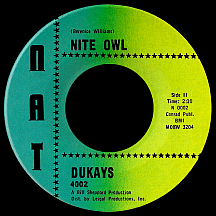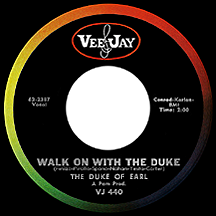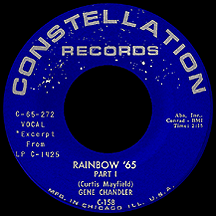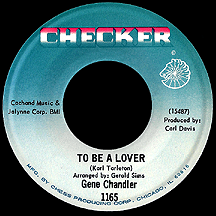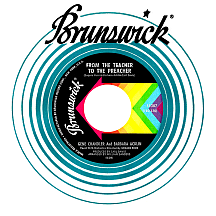GENE CHANDLER
He began singing with one doo wop group, then joined another. He served time in the Army, then returned and had a minor hit with the second group. Afterwards he topped the charts with one of the most notorious hits of the 1960s, then gradually established himself as one of the decade's masters of smooth, sensual soul. This could be the outline for the career of any number of singers (minus the notorious number one hit, perhaps). "Duke of Earl" is the song in question, an impromptu creation by Eugene Dixon and the group he was in, The Dukays, that led to a parting of the ways for those involved once the record's reach extended far and wide.
Dixon was born in Chicago in 1937 and grew up on the city's south side, in and around the Englewood district. After a brief stint with a high school group called The Gaytones, he joined the Dukays as lead singer, fitting in well with founding members Earl Edwards, James Lowe and Ben Broyles. A detour into the U.S. Army slowed their progress, but the group held a spot for him until his discharge in 1960. Feeling a certain amount of control, he urged the others to consider Shirley Johnson, his cousin, envisioning a lineup similar to The Platters but with more of a street-level image, something the Tony Williams-led quintet had drifted away from some years earlier. They approved this emphasis-shifting move and found themselves making records more quickly than anyone imagined.
Bernice Williams, a Chicago songwriter with connections at the local Nat label, got them in the door and into the studio. With Bill "Bunky" Sheppard at the helm, the Dukays waxed a tune Bernice had written, "The Girl's a Devil," and in May 1961 it settled in for a three month run on the charts, cruising the lower 40 as stations around the country played the track, though few ever fully committed to it. "Nite Owl" was chosen as the second single and released in the fall, but it was another Dukays song, "Duke of Earl," that had the goods to take them over the top. Trouble was, Nat Records bosses didn't think it had any potential. When they declined to release it, Sheppard and promotion man Carl Davis shopped the master around town, finding interest at Gary, Indiana-based Vee-Jay Records. A&R head Calvin Carter instantly recognized the song's potential, but it was a sticky situation; with the Dukays on another label, they decided to release the record as a solo Eugene Dixon single. In an attempt to avoid contract issues, Dixon changed his name to Gene Chandler, which he felt had a nice ring to it...besides, he and Davis were both fans of Jeff Chandler, the recently-deceased actor with more than 40 film credits including the Oscar-nominated role of Cochise in Broken Arrow.
"Duke of Earl" began impacting the airwaves over the Christmas holidays. Hitting the national charts in early January, the over-the-top doo wop throwback rose quickly, reaching number one by mid-February '62. "Nite Owl" also appeared on the charts in January, due perhaps to a promotional push by Nat Records in an effort to ride the coattails of Gene's rapidly-developing hit. Despite efforts to pave their own road to success, including a brief tenure with Vee-Jay, the Dukays eventually called it quits. In trying to capitalize on the huge exposure he'd gained with the chart-topping hit, Gene had difficulties of his own. Someone suggested he wear some kind of getup that might capitalize on the "Duke" image; as a result he began doing his act decked out in a top hat and cape, carrying a cane and even wearing a monocle over his left eye (he appeared like this in the April film release Don't Knock the Twist, preserved for future generations to marvel at).
Vee-Jay released an answer song, "Duchess of Earl" by The Pearlettes, a Los Angeles-based girl group. Attempts to milk the concept got out of hand; Gene's own sequel, "Walk On with the Duke," came immediately afterward and was credited to The Duke of Earl! The "Duke" sequel fared poorly and the costumed stage routine wore thin in a matter of months. Worse yet, it cheapened what had begun as a simply great record. A lesser artist would likely have been unable to rebound (in fact, many a talented singer has suffered due to an ill-considered follow-up or lack of a long-term plan). Gene began a long series of attempts to turn things around. After two more records under the Duke of Earl name, "Tear For Tear," a heartfelt midtempo R&B song, showed label credit as Gene "Duke of Earl" Chandler.
The nickname was dropped for good with the next single, but the song itself was purposely gimmicky: "You Threw a Lucky Punch" was no more than an answer song to Mary Wells' huge Motown smash "You Beat Me to the Punch." Chandler wanted the label to promote the flip side, an exceptional rendition of "Rainbow," written by Curtis Mayfield, but they chose to play it safe; that is, if your definition of "safe" is to live for the moment and disregard an artist's image or future potential. Gene promoted the song on his own whenever possible, going so far as to call radio stations and hawk the flip side in a form of defiance to the label's plans. Ultimately it was a smart move. "You Threw" was basically a throwaway; "Rainbow" was a keeper, ultimately the more successful side after stations began flipping the single over in early '63.
The trick was to then build on the momentum gained through a hit that was still far below the blockbuster status of "Duke." Critics began to take note; R&B stations took a closer look at this singer who on the surface appeared to be a one-shot novelty act, but in some ways now seemed like a different person altogether. "Check Yourself" (a reworking of an early tune by The Temptations) and "Man's Temptation," another strong Mayfield song, brought him closer to his goal. When Bunky Sheppard and Vee-Jay co-owner Ewart Abner started Constellation Records in 1963, Chandler became the label's main focus; Sheppard handled production duties as he had at Vee-Jay, Carl Davis and Johnny Pate showed support in the studio, and Gene's profile steadily grew. Mayfield came up with "Think Nothing About It," featuring backing vocals by The Impressions, an appealing effort that unfortunately did little in the way of exposing Gene's own unique style. "Soul Hootenanny" was an odd choice, a medley, recorded in concert, of VJ bluesman Jimmy Reed's 1961 hit "Big Boss Man" and the hook from Marvin Gaye's "Can I Get a Witness" (note the recurring Motown influence in Gene's work).
Mayfield's "Just Be True" ended the long wait and relieved any doubts, returning Gene to both the top ten of the R&B chart and the pop top 20. The ballad began a streak of intensely romantic hits over the next year: "Bless Our Love" (a Billy Butler song) and "What Now" (written by Mayfield) made strong showings on pop and R&B charts. In the spring of '65, "Nothing Can Stop Me" (also from the pen of Mayfield) became his biggest hit since "Duke" more than three years earlier. With a vocal style that captured the imagination of a predominantly black female audience, he became a symbol of love, romance and, sometimes, inevitable heartbreak.
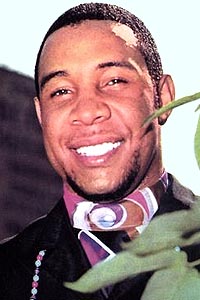
Gene considered "Rainbow" the turning point in his career and performed it at every show, usually in extended versions or as an encore. A live Regal Theater version hit big as "Rainbow '65," going as high as number two on the R&B charts in early 1966 (his connection to the song was so deep he recorded it a third time some years later). Apart from Gene's success, Constellation struggled in spite of a fine, mostly Chicago-bred roster of acts. The label closed its doors in 1966 and Gene moved on to record for Chess subsidiary Checker, later signing with Brunswick Records, with Carl Davis producing most of his sessions during the next few years. Singles came out on both labels for awhile, the most successful being "I Fooled You This Time" and "To Be a Lover" on Checker, alternating with Brunswick hits like "Girl Don't Care" and a lyrically-adjusted cover of James Brown's "There Was a Time" (replacing Brown's self-centered lyrical content, all in good fun of course, with Chandler's own brand of braggadocio). In 1968 he teamed with Carl Davis discovery Barbara Acklin for his first hits as part of a duet, "Show Me the Way To Go" and "From the Teacher to the Preacher" (both written by Acklin and Davis with Eugene Record of The Chi-Lites). Barbara also scored solo that year with "Love Makes a Woman."
Chandler's career seemed to hit the doldrums in 1969. None of his own records were hits, but with Karl Tarleton (who'd written "To Be a Lover" and other songs) he produced a smash for Mel and Tim, "Backfield in Motion," on Bamboo Records. He ran his own label, Mr. Chand, for a few years and signed with Mercury Records in 1970. "Groovy Situation" hit strong in the summer of '70 and was certified for sales of over a million copies. He and fellow Chicago soul legend Jerry Butler made some records for Mercury as Gene and Jerry, including "You Just Can't Win (By Making the Same Mistake)" in '71. He was in the top ten of the Soul (formerly R&B) charts as late as 1979 with "Get Down," a track that simmered with disco heat. Since then the still-energetic Gene Chandler has kept a consistent schedule of live dates and occasional recording sessions.
NOTABLE SINGLES:
- The Girl's a Devil - 1961
by The Dukays - Duke of Earl - 1962
- Nite Owl - 1962
by The Dukays - Walk On with the Duke - 1962
as the Duke of Earl - Tear For Tear - 1962
as Gene "Duke of Earl" Chandler - You Threw a Lucky Punch - 1962 /
Rainbow - 1963 - Check Yourself - 1963
- Man's Temptation - 1963
- Think Nothing About It - 1964
- Soul Hootenanny - 1964
- Just Be True - 1964
- Bless Our Love - 1964
- What Now - 1964
- You Can't Hurt Me No More - 1965
- Nothing Can Stop Me - 1965
- Good Times - 1965
- Here Come the Tears - 1965
- Rainbow '65 - 1965
- (I'm Just A) Fool For You - 1966
- I Fooled You This Time - 1966
- Girl Don't Care - 1967
- To Be a Lover - 1967
- There Goes the Lover - 1967
- Show Me the Way To Go - 1968
with Barbara Acklin - River of Tears - 1968
- There Was a Time - 1968
- From the Teacher to the Preacher - 1968
with Barbara Acklin - Groovy Situation - 1970
- Simply Call it Love - 1970
- You Just Can't Win (By Making the Same Mistake) - 1971
with Jerry Butler (as Gene and Jerry) - You're a Lady - 1971
- Get Down - 1978


